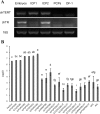Immortalization of chicken preadipocytes by retroviral transduction of chicken TERT and TR
- PMID: 28486516
- PMCID: PMC5423695
- DOI: 10.1371/journal.pone.0177348
Immortalization of chicken preadipocytes by retroviral transduction of chicken TERT and TR
Abstract
The chicken is an important agricultural animal and model for developmental biology, immunology and virology. Excess fat accumulation continues to be a serious problem for the chicken industry. However, chicken adipogenesis and obesity have not been well investigated, because no chicken preadipocyte cell lines have been generated thus far. Here, we successfully generated two immortalized chicken preadipocyte cell lines through transduction of either chicken telomerase reverse transcriptase (chTERT) alone or in combination with chicken telomerase RNA (chTR). Both of these cell lines have survived >100 population doublings in vitro, display high telomerase activity and have no sign of replicative senescence. Similar to primary chicken preadipocytes, these two cell lines display a fibroblast-like morphology, retain the capacity to differentiate into adipocytes, and do not display any signs of malignant transformation. Isoenzyme analysis and PCR-based analysis confirmed that these two cell lines are of chicken origin and are free from inter-species contamination. To our knowledge, this is the first report demonstrating the generation of immortal chicken cells by introduction of chTERT and chTR. Our established chicken preadipocyte cell lines show great promise as an in vitro model for the investigation of chicken adipogenesis, lipid metabolism, and obesity and its related diseases, and our results also provide clues for immortalizing other avian cell types.
Conflict of interest statement
Figures







Similar articles
-
Alternative splicing and nonsense-mediated decay regulate telomerase reverse transcriptase (TERT) expression during virus-induced lymphomagenesis in vivo.BMC Cancer. 2010 Oct 21;10:571. doi: 10.1186/1471-2407-10-571. BMC Cancer. 2010. PMID: 20964812 Free PMC article.
-
Immortalization in a normal foreskin fibroblast culture following transduction of cyclin A2 or cdk1 genes in retroviral vectors.Exp Cell Res. 2004 Apr 1;294(2):406-19. doi: 10.1016/j.yexcr.2003.11.030. Exp Cell Res. 2004. PMID: 15023530
-
The chicken telomerase reverse transcriptase (chTERT): molecular and cytogenetic characterization with a comparative analysis.Gene. 2004 Sep 15;339:61-9. doi: 10.1016/j.gene.2004.05.024. Gene. 2004. PMID: 15363846
-
Involvement of the oncoprotein c-Myc in viral telomerase RNA gene regulation during Marek's disease virus-induced lymphomagenesis.J Virol. 2007 May;81(9):4848-57. doi: 10.1128/JVI.02530-06. Epub 2007 Feb 21. J Virol. 2007. PMID: 17314164 Free PMC article.
-
Reconstitution of human telomerase reverse transcriptase expression rescues colorectal carcinoma cells from in vitro senescence: evidence against immortality as a constitutive trait of tumor cells.Cancer Res. 2005 Mar 15;65(6):2321-9. doi: 10.1158/0008-5472.CAN-04-3678. Cancer Res. 2005. PMID: 15781646
Cited by
-
Transcriptome Sequencing Reveals Pathways Related to Proliferation and Differentiation of Shitou Goose Myoblasts.Animals (Basel). 2022 Oct 27;12(21):2956. doi: 10.3390/ani12212956. Animals (Basel). 2022. PMID: 36359079 Free PMC article.
-
From the raw bar to the bench: Bivalves as models for human health.Dev Comp Immunol. 2019 Mar;92:260-282. doi: 10.1016/j.dci.2018.11.020. Epub 2018 Nov 29. Dev Comp Immunol. 2019. PMID: 30503358 Free PMC article. Review.
-
A unique spontaneously immortalised cell line from pig with enhanced adipogenic capacity.NPJ Sci Food. 2025 Apr 20;9(1):52. doi: 10.1038/s41538-025-00413-y. NPJ Sci Food. 2025. PMID: 40254637 Free PMC article.
-
Long Noncoding RNA 6302 Regulates Chicken Preadipocyte Differentiation by Targeting SLC22A16.Genes (Basel). 2024 Jun 9;15(6):758. doi: 10.3390/genes15060758. Genes (Basel). 2024. PMID: 38927694 Free PMC article.
-
Establishment and Characterization of a Chicken Myoblast Cell Line.Int J Mol Sci. 2024 Jul 30;25(15):8340. doi: 10.3390/ijms25158340. Int J Mol Sci. 2024. PMID: 39125909 Free PMC article.
References
-
- Ji B, Ernest B, Gooding JR, Das S, Saxton AM, Simon J, et al. Transcriptomic and metabolomic profiling of chicken adipose tissue in response to insulin neutralization and fasting. BMC Genomics. 2012;13: 441 doi: 10.1186/1471-2164-13-441 - DOI - PMC - PubMed
-
- Simon J. Chicken as a useful species for the comprehension of insulin action. Crit Rev Poultry Biol. 1989;2: 121–148.
-
- Akiba Y, Chida Y, Takahashi T, Ohtomo Y, Sato K, Takahashi K. Persistent hypoglycemia induced by continuous insulin infusion in broiler chickens. Br Poult Sci. 1999;40: 701–705. doi: 10.1080/00071669987124 - DOI - PubMed
-
- Tokushima Y, Sulistiyanto B, Takahashi K, Akiba Y. Insulin-glucose interactions characterised in newly hatched broiler chicks. Br Poult Sci. 2003;44: 746–751. doi: 10.1080/00071660310001645758 - DOI - PubMed
-
- Dupont J, Metayer-Coustard S, Ji B, Rame C, Gespach C, Voy B, et al. Characterization of major elements of insulin signaling cascade in chicken adipose tissue: apparent insulin refractoriness. Gen Comp Endocrinol. 2012;176: 86–93. doi: 10.1016/j.ygcen.2011.12.030 - DOI - PubMed
MeSH terms
Substances
LinkOut - more resources
Full Text Sources
Other Literature Sources
Research Materials

